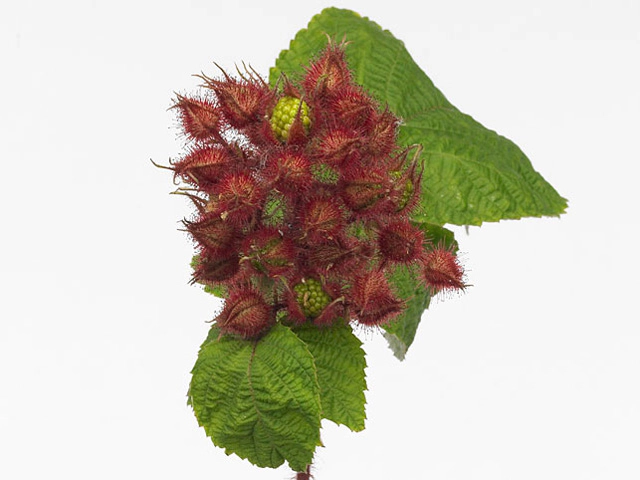Rubus phoenicolasius

| Leaf tip | Pointed/acute |
| Leaf margin | Erose |
| Winter hardness | Good (USDA-zone 5, 6) |
| Flower color | White; Light red pink |
| Fruit color | Orange; Red |
| Leaf, general shape | Cordate (heart-shaped); Circular; Oval / elliptic |
| Plant height | 2,5 - 3 m |
| Inflorescence | Corymb |
| Flowering month(s) | June; July |
| Fruit size | 1 - 1,5 cm |
| Leaf duration | Deciduous |
| Leaf size | 7,5 - 10 cm |
| Light conditions | Semi-shades; Sunny |
| Leaf division | Tricompound |
| Inflorescence length | 10 - 15 cm |
| Inflorescence diameter | 10 - 15 cm |
| Plant, growth type | Pendulous; Erect |
| Leaf, main color | Dark green; Dark green |
| Leaf, secondary color(s) | White |
| Toxicity (if consumed) | Not or barely |
| Moisture requirements | Well-drained |
| Soil type | Humus rich |
The Rubus phoenicolasius, commonly known as the blackberry or wineberry, is a versatile and attractive plant that belongs to the Rosaceae family. This deciduous plant is known for its heart-shaped or oval/elliptic leaves, which can vary in size from 7.5 to 10 cm. The leaf color is predominantly dark green, with white secondary colors, giving it a unique and striking appearance.
One of the distinguishing features of the Rubus phoenicolasius is its pointed/acute leaf tip, which adds to its aesthetic appeal. The leaf margin is erose, contributing to its overall texture. The plant grows to a height of 2.5-3 meters, making it a suitable choice for both gardens and larger landscapes.
During the months of June and July, the Rubus phoenicolasius produces beautiful white or light red-pink flowers. These flowers are arranged in corymbs, with inflorescence lengths and diameters ranging from 10 to 15 cm. The inflorescence's impressive display adds charm and elegance to any setting.
In the late summer and early autumn, the blackberry plant bears its edible fruits. The fruit color ranges from orange to red, making it visually appealing and enticing to both humans and wildlife. The fruit size measures between 1 and 1.5 cm, and it is well-regarded for its sweet and juicy taste.
The Rubus phoenicolasius thrives in semi-shaded to sunny light conditions. It adapts well to various soil types, but it prefers well-drained, humus-rich soil. This plant exhibits good winter hardness, making it suitable for USDA zones 5 and 6.
In terms of growth type, the Rubus phoenicolasius can be either pendulous or erect, providing versatility in landscaping options. It is a hardy plant that requires minimal maintenance once established, making it an ideal choice for those with limited gardening experience.
One important characteristic of the Rubus phoenicolasius is its low toxicity. While it is generally safe for consumption, it is always wise to exercise caution when consuming any plant material.
Overall, the Rubus phoenicolasius, with its attractive foliage, beautiful flowers, and delicious fruits, is a desirable addition to any garden or landscape. Its adaptability to different light conditions and soil types, combined with its low maintenance requirements and ability to withstand harsh winters, make it a popular choice among gardeners and horticulture enthusiasts. Whether used as an ornamental plant or for its culinary uses, the Rubus phoenicolasius is sure to bring beauty and enjoyment to any outdoor space.
Market availability index by month:
| Jan. | Feb. | Mar. | Apr. | May | Jun. | Jul. | Aug. | Sep. | Oct. | Nov. | Dec. |
|---|---|---|---|---|---|---|---|---|---|---|---|
| - | - | - | - | 1 | 4 | 3 | 3 | - | - | - | - |